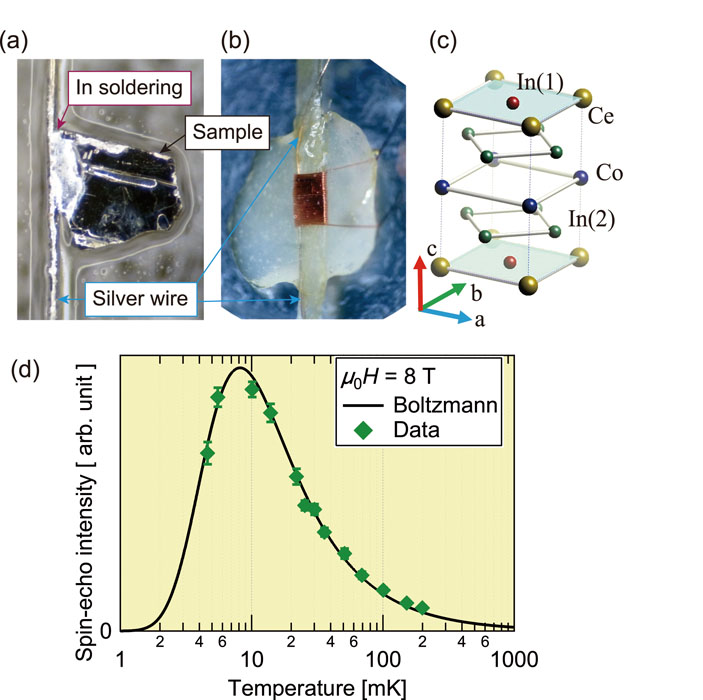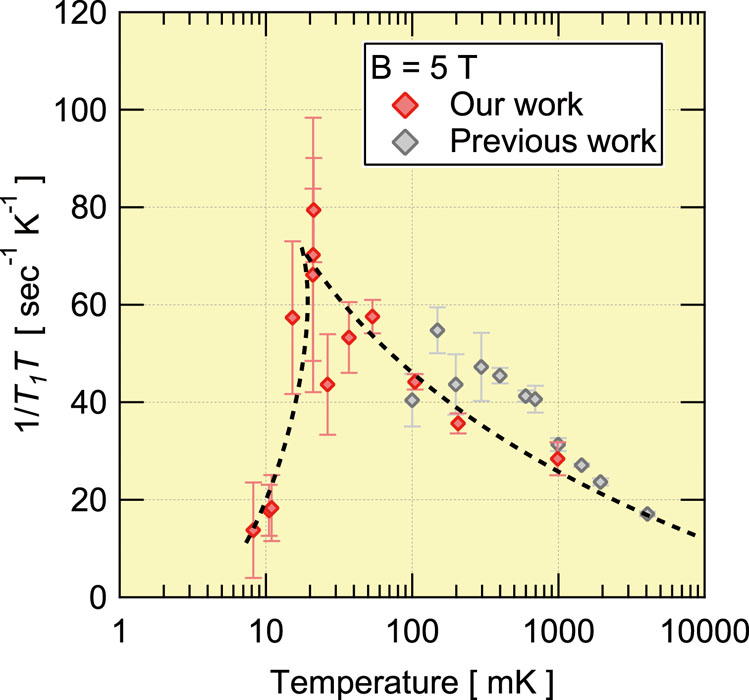Ultralow Temperature NMR of CeCoIn5
Yamashita and Takigawa Groups
We have established the experimental procedures to measure high-field spin-echo NMR signals down to ultralow temperatures (~1 mK) with ensuring the thermal equilibrium between the sample and the cryostat [1]. This technique allows us to observe a peak in 1 ∕ T1T of 59Co NMR signals at ~20 mK, showing a magnetic transition in CeCoIn5.
Understanding the role of enhanced quantum fluctuations near a magnetic quantum critical point (QCP) has been a central issue in condensed-matter physics, because such quantum fluctuations are believed to mediate various exotic phenomena, such as non-Fermi liquid behaviors, enhancements of effective mass, and unconventional Cooper pairings. Many studies of unconventional superconductivity near a magnetic QCP have been performed in heavy-fermion materials. Among the various heavy-fermion materials, CeCoIn5 has been attracting broad attention because of its d-wave superconducting state with the high transition temperature of 2.3 K and the proximity to a putative magnetic QCP. However, no antiferromagnetic (AFM) state corresponding to the QCP has been observed, shrouding the origin of the QCP in mystery.
Recently, we have reported anomalous decrease in the de Haas–van Alphen (dHvA) amplitudes of CeCoIn5 below 20 mK for 6–10 T [2]. An appearance of a field-induced AFM phase has been put forward to explain the decrease of the dHvA amplitude, because additional dissipation by magnetic breakdowns in the AFM phase can provide the most plausible explanation for the decrease of the dHvA amplitude. However, direct evidence of magnetic order has yet to be observed.
In this work, we performed spin-echo NMR measurements down to 5 mK to find the magnetic order. It is a very challenging issue to observe NMR signals down to ultralow temperatures without heating the sample. First, we made a strong thermal connection between the sample and the cryostat by indium soldering a silver wire to the sample (Fig. 1). Second, we find that the temperature dependence of the spin-echo intensity ISE(T) provides a good measure of the sample temperature. By taking into account the population difference of the nuclear spins in different energy levels which have the Boltzmann distribution, one can find the temperature dependence of ISE(T) as shown by the solid line in Fig. 1d. We confirm that the NMR signal follows the Boltzmann curve when the heating caused by the NMR pulses is negligible (Fig. 1d), allowing us to find a pulse condition without heating the sample.

Fig. 1. (a) A picture of the sample with a silver wire (100 μm diameter) soldered by indium. (b) Cu wires were wound around the sample for NMR measurements. The silver wire was thermally anchored to the cryostat. (c) Crystal structure of CeCoIn5. NMR measurements were performed at 59Co (I = 7∕2) nuclei. (d) The temperature dependence of the spin-echo intensity at 8 T. The solid line shows the calculation from the Boltzmann distribution of the nuclear spins.
Having established the NMR pulse conditions without heating of the sample, we investigate the temperature dependence of the longitudinal relaxation time (T1). We find a pronounced peak in 1 ∕ T1T at 5 T, implying an appearance of magnetic order as suggested by our previous dHvA measurements [2]. On the other hand, the NMR spectrum shows no change below 20 mK. Moreover, the peak in 1 ∕ T1T disappears at 6 and 8 T in contrast to the results of the quantum oscillation. We discuss that an antiferromagnetic state with a moment lying in the a–b plane can be a possible origin for the peak in 1 ∕ T1T at 5 T.
References
- [1] M. Yamashita et al., Phys. Rev. B 102, 165154 (2020).
- [2] H. Shishido et al., Phys. Rev. Lett. 120, 177201 (2018).
- [3] T. Taniguchi et al., JPS Conf. Proc. 30, 011107 (2020).

